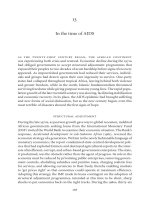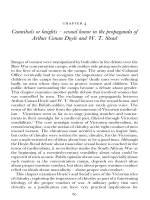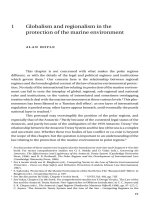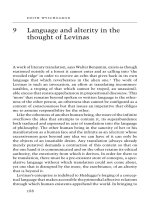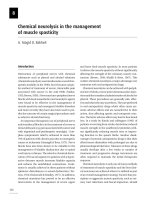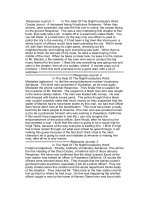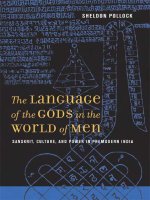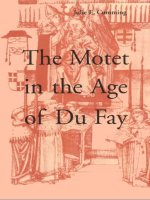Jason stearns dancing in the glory of monste ica (v5 0)
Bạn đang xem bản rút gọn của tài liệu. Xem và tải ngay bản đầy đủ của tài liệu tại đây (2.76 MB, 309 trang )
Table of Contents
Title Page
Dedication
Acknowledgements
Acronyms
Introduction
PART I - PREWAR
Chapter 1 - THE LEGACY OF GENOCIDE
GISENYI, RWANDA, JULY 17, 1994
Chapter 2 - AIDING AND ABETTING
INERA REFUGEE CAMP, ZAIRE, OCTOBER 1994
Chapter 3 - A COUNTRY IN RUINS
KIGALI, RWANDA, JULY 1994–SEPTEMBER 1996
Chapter 4 - SIX DAYS
BUKAVU, ZAIRE, OCTOBER 8, 1996
Chapter 5 - ONION LAYERS
MUSHAKI, ZAIRE, AND KIGALI, RWANDA, OCTOBER 1993
Chapter 6 - MZEE
KIGALI, RWANDA, EARLY 1996; LUBUMBASHI, CONGO, 1960; FIZI, CONGO, 1965–
1980
PART II - THE FIRST WAR
Chapter 7 - MANY WARS IN ONE
KIRINGYE, LWEBA, AND ABALA, ZAIRE, AUGUST–OCTOBER 1996
Chapter 8 - THE DOMINOES FALL
BUKAVU, ZAIRE, OCTOBER 1996
Chapter 9 - A THOUSAND MILES THROUGH THE JUNGLE
BUKAVU, ZAIRE, OCTOBER 1996
Chapter 10 - THIS IS HOW YOU FIGHT
BUKAVU AND LEMERA, ZAIRE, OCTOBER 1996
Chapter 11 - A WOUNDED LEOPARD
KINSHASA, ZAIRE, DECEMBER 1996
Chapter 12 - THE KING IS DEAD; LONG LIVE THE KING
KINSHASA, CONGO, MAY 1997
PART III - THE SECOND WAR
Chapter 13 - ONE WAR TOO MANY
RUHENGERI, RWANDA, AND KINSHASA, CONGO, AUGUST 1998
Chapter 14 - THE REBEL PROFESSOR
KIGALI, RWANDA, AUGUST 1998
Chapter 15 - THE REBEL START-UP
GBADOLITE, CONGO, JULY 1999
Chapter 16 - CAIN AND ABEL
KISANGANI, CONGO, MAY 1999
Chapter 17 - SORCERERS’ APPRENTICES
EASTERN CONGO, JUNE 2000
Chapter 18 - THE ASSASSINATION OF MZEE
KINSHASA, CONGO, JANUARY 17, 2001
Chapter 19 - PAYING FOR THE WAR
GOMA, ZAIRE, NOVEMBER 1996
PART IV - NEITHER WAR NOR PEACE
Chapter 20 - THE BEARER OF EGGS
KINSHASA, CONGO, JANUARY 2001
Conclusion: The Congo, On Its Own Terms
Notes
Index
Copyright Page
For Lusungu
Acknowledgments
My thanks go to the many Congolese, Rwandans, Burundians, and Ugandans who helped me write this
book and whose names appear in these pages. They were generous enough to sit with me for many
hours and explain their experiences. Others I could not name so as not to get them in trouble—you
know who you are, asanteni.
I owe a special debt to Kizito Mushizi, Raphael Wakenge, Christian Mukosa, and their families,
whose warm support since I first arrived in Bukavu made me appreciate the complexities and beauty
of their country. I am also grateful for the help provided by Remy Ngabo, Gandy Rugemintore, Balzac
Buzera, Pascal Kambale, Willy Nindorera, Noel Atama, Adelar Mivumba, James Habyarimana,
Soraya Aziz, Tshivu Ntite, Thomas Ntiratimana, Mvemba Dizolele, Thomas Luhaka, and Michel
Losembe in understanding the shifting sands of Congolese politics and in opening doors for me.
My research relied heavily on the hospitality of friends and strangers. To several generations of
dedicated journalists in Kinshasa, thanks for the couch, the conspiracies, and insider advice—
especially the Reuters crew of Dinesh Mahtani, David Lewis and Joe Bavier, but also Franz Wild,
Arnaud Zajtman, Thomas Fessy, and Michael Kavanagh. James Astill and Marcos Lorenzana were
important companions through the early stages of the book, and Wim Verbeken, Eddie Kariisa, and
Jean-Jacques Simon provided wonderful hospitality. Federico Borello, Louazna Khalouta, Matt
Green, Djo Munga, and Johan Peleman were also often on hand to help me out with support and
expert advice.
Great Lakes politics is a minefield of stereotypes and misinformation. I was fortunate to have
experienced scholars and researchers to help me navigate, including David and Catharine Newbury,
Herbert Weiss, Peter Rosenblum, Anneke van Woudenberg, and Ida Sawyer. My friends Serge
Maheshe and Alison Des Forges saw me begin this project and encouraged me along, but, sadly,
neither could see it finished. They will be sorely missed.
This was my first experience of writing and publishing a book. Many people helped me through the
process. Thanks to my parents, my wife, and my brother for so patiently reading the various drafts and
providing comments. Michela Wrong believed in this project from the beginning and provided moral
and literary support, as did my agent, Robert Guinsler, and editor, Clive Priddle.
This book benefited from the support of the Rockefeller Foundation, whose generous fellowship
allowed me to enjoy peace and quiet at the Bellagio Center for a month so I could make sense of my
notes.
Acronyms
ADF Allied Democratic Forces (Uganda)
ADM Allied Democratic Movement (Uganda)
AFDL Alliance of Democratic Forces for the Liberation of Congo- Zaire
AIDS Acquired Immune Deficiency Syndrome
BBC British Broadcasting Corporation
CIA Central Intelligence Agency
COMIEX Mixed Import-Export Company
COPACO Collective of Congolese Patriots
DRC Democratic Republic of the Congo
FAR Rwandan Armed Forces
FAZ Zairian Armed Forces
FDD Forces for the Defense of Democracy (Burundi)
FDLR Democratic Forces for the Liberation of Rwanda
FLEC Front for the Liberation of the Enclave of Cabinda (Angola)
FNI National and Integrationist Front (Congo)
FNL National Liberation Forces (Burundi)
FRPI Patriotic Resistance Forces of Ituri (Congo)
ICHEC Catholic Institute of Higher Commercial Studies
IRC International Rescue Committee
LRA Lord’s Resistance Army (Uganda)
MLC Movement for the Liberation of the Congo
MPR Popular Revolutionary Movement
MRC Congolese Revolutionary Movement
NALU National Army for the Liberation of Uganda
NATO North Atlantic Treaty Organization
NGO Non-Governmental Organization
NRM National Resistance Movement (Uganda)
OECD Organization for Economic Co-operation and Development
OSLEG Operation Sovereign Legitimacy
RCD Congolese Rally for Democracy
RCD-N Congolese Rally for Democracy-National
RPA Rwandan Patriotic Army (the armed wing of the RPF)
RPF Rwandan Patriotic Front
SADC South African Development Community
UMLA Uganda Muslim Liberation Army
UNESCO United Nations Educational, Scientific, and Cultural Organization
UNHCR United Nations High Commissioner for Refugees
UNITA National Union for the Total Independence of Angola
UNOSOM United Nations Operation in Somalia
UPC Union of Congolese Patriots (Congo)
UPDF Uganda People’s Defense Force
WNBLF West Nile Bank Liberation Front (Uganda)
Introduction
Understanding the Violence
Power is Eaten Whole.
—CONGOLESE SAYING
This is how it usually worked: I would call up one of the people whose names I had written down in
my notebook, and I’d tell him I was writing a book on the war in the Congo and that I wanted to hear
his story. Most people like to talk about their lives, and almost everybody—Congolese ministers,
army commanders, former child soldiers, diplomats—accepted. We would typically meet in a public
place, as they wouldn’t feel comfortable talking about sensitive matters in their offices or homes, and
they would size me up: a thirty-year-old white American. Many asked me, “Why are you writing this
book?” When I told them that I wanted to understand the roots of the violence that has engulfed the
country since 1996, they often replied with a question, “Who are you to understand what I am telling
you?”
The look of bemusement would frequently appear in the eyes of interviewees. An army commander
spent most of our meeting asking me what I thought of the Congo, trying to pry my prejudices out of
me before he told me his story. “Everybody has an agenda,” he told me. “What’s yours?” A local,
illiterate warlord with an amulet of cowries, colonial-era coins, and monkey skulls around his neck
shook his head at me when I took his picture, telling me to erase it: “You’re going to take my picture
to Europe and show it to other white people. What do they know about my life?” He was afraid, he
told me, that they would laugh at him, think he was a macaque, some forest monkey.
He had good reason to be skeptical. There is a long history of taking pictures and stories from
Central Africa out of context. In 1904, an American missionary brought Ota Benga, a pygmy from the
central Congo, to the United States. He was placed in the monkey house at the Bronx Zoo in New
York City, where his filed teeth, disproportionate limbs and tricks helped attract 40,000 visitors a
day. He was exhibited alongside an orangutan, with whom he performed tricks, in order to emphasize
Africans’ similarities with apes. An editorial in the New York Times , rejecting calls for his release,
remarked that “pygmies are very low in the human scale.... The idea that men are all much alike
except as they have had or lacked opportunities for getting an education out of books is now far out of
date.”
While not as shockingly racist, news reports from the Congo still usually reduce the conflict to a
simplistic drama. An array of caricatures is often presented: the corrupt, brutal African warlord with
his savage soldiers, raping and looting the country. Pictures of child soldiers high on amphetamines
and marijuana—sometimes from Liberia and Sierra Leone, a thousand miles from the Congo. Poor,
black victims: children with shiny snot dried on their faces, flies buzzing around them, often in camps
for refugees or internally displaced. Between these images of killers and victims, there is little room
to challenge the clichés, let alone try to offer a rational explanation for a truly chaotic conflict.
The Congo wars are not stories that can be explained through such stereotypes. They are the
product of a deep history, often unknown to outside observers. The principal actors are far from just
savages, mindlessly killing and being killed, but thinking, breathing Homo sapiens, whose actions,
however abhorrent, are underpinned by political rationales and motives.
The Democratic Republic of the Congo is a vast country, the size of western Europe and home to sixty
million people. For decades it was known for its rich geology, which includes large reserves of
cobalt, copper, and diamonds, and for the extravagance of its dictator Mobutu Sese Seko, but not for
violence or depravity.
Then, in 1996, a conflict began that has thus far cost the lives of over five million people.
The Congolese war must be put among the other great human cataclysms of our time: the World
Wars, the Great Leap Forward in China, the Rwandan and Cambodian genocides. And yet, despite its
epic proportions, the war has received little sustained attention from the rest of the world. The
mortality figures are so immense that they become absurd, almost meaningless. From the outside, the
war seems to possess no overarching narrative or ideology to explain it, no easy tribal conflict or
socialist revolution to use as a peg in a news piece. In Cambodia, there was the despotic Khmer
Rouge; in Rwanda one could cast the genocidal Hutu militias as the villains. In the Congo these roles
are more difficult to fill. There is no Hitler, Mussolini, or Stalin. Instead it is a war of the ordinary
person, with many combatants unknown and unnamed, who fight for complex reasons that are difficult
to distill in a few sentences—much to the frustration of the international media. How do you cover a
war that involves at least twenty different rebel groups and the armies of nine countries, yet does not
seem to have a clear cause or objective? How do you put a human face on a figure like “four million”
when most of the casualties perish unsensationally, as a result of disease, far away from television
cameras?
The conflict is a conceptual mess that eludes simple definition, with many interlocking narrative
strands. The New York Times , one of the few American newspapers with extensive foreign coverage,
gave Darfur nearly four times the coverage it gave the Congo in 2006, when Congolese were dying of
war-related causes at nearly ten times the rate of those in Darfur. 1 Even Nicholas Kristof, the Times
columnist who has campaigned vigorously for humanitarian crises around the world, initially used the
confusion of the Congo as a justification for reporting on it less—it is less evil because it is less
ideologically defined. He writes:
Darfur is a case of genocide, while Congo is a tragedy of war and poverty.... Militias slaughter each
other, but it’s not about an ethnic group in the government using its military force to kill other groups.
And that is what Darfur has been about: An Arab government in Khartoum arming Arab militias to
kill members of black African tribes. We all have within us a moral compass, and that is moved
partly by the level of human suffering. I grant that the suffering is greater in Congo. But our compass is
also moved by human evil, and that is greater in Darfur. There’s no greater crime than genocide, and
that is Sudan’s specialty.2
What is the evil in the Congo? How can we explain the millions of deaths?
In 1961, the philosopher Hannah Arendt traveled to Jerusalem to witness the trial of a great Nazi
war criminal, Adolph Eichmann, who had been in charge of sending hundreds of thousands of Jews to
their deaths. Herself a Jewish escapee from the Holocaust, Arendt was above all interested in the
nature of evil. For her, the mass killing of Jews had been possible through a massive bureaucracy that
dehumanized the victims and dispersed responsibility through the administrative apparatus. Eichmann
was not a psychopath but a conformist. “I was just doing my job,” he told the court in Jerusalem. This,
Arendt argued, was the banality of evil.
This book takes Arendt’s insight as its starting point. The Congo obviously does not have the
anonymous bureaucracy that the Third Reich did. Most of the killing and rape have been carried out at
short range, often with hatchets, knives, and machetes. It is difficult not to attribute personal
responsibility to the killers and leaders of the wars.
It is not, however, helpful to personalize the evil and suggest that somehow those involved in the
war harbored a superhuman capacity for evil. It is more useful to ask what political system produced
this kind of violence. This book tries to see the conflict through the eyes of its protagonists and
understand why war made more sense than peace, why the regional political elites seem to be so rich
in opportunism and so lacking in virtue.
The answers to these questions lie deeply embedded in the region’s history. But instead of being a
story of a brutal bureaucratic machine, the Congo is a story of the opposite: a country in which the
state has been eroded over centuries and where once the fighting began, each community seemed to
have its own militia, fighting brutal insurgencies and counterinsurgencies with each other. It was more
like seventeenth-century Europe and the Thirty Years’ War than Nazi Germany.
For centuries the Congo has held a fascination for outsiders. Lying at the heart of the African
continent, and encompassing some of the continent’s most impenetrable jungles, it has long been
associated with violence and injustice. In 1885, during the scramble to divide Africa among colonial
powers, King Leopold II of Belgium claimed the country as his personal fiefdom. He set up the Congo
Free State, a private enterprise, and during the rubber boom of the 1890s the country became a key
source of latex for car and bicycle tires. Colonial officers created a draconian system of forced labor
during which they killed or mutilated hundreds of thousands and pushed millions of others to
starvation or death from disease.
This brutality prompted the first international human rights campaign, led by missionaries and
activists, including Mark Twain and Arthur Conan Doyle. Under pressure, King Leopold capitulated
and handed the country over to the Belgian government in 1908. Although they established a much
more elaborate administration with extensive primary education, the Belgians still focused on
extracting resources and did little to encourage Congolese development. The upper echelons of the
military and civil service were entirely white, pass laws kept Congolese from living in upper-class
neighborhoods, and education was limited to the bare minimum.
By the time they were forced to hand over power, the Belgians had set the new nation up to fail. As
the novelist Achille Ngoye vents through one of his characters: “I don’t like these uncles mayonnaisefries3 for their responsibility in the debacle of our country: seventy-five years of colonization, one
[Congolese] priest by 1917, five [Congolese] warrant officers in an army of sergeants and corporals
in 1960, plus five pseudo-university graduates at independence; a privileged few chosen based on
questionable criteria to receive a hasty training to become managers of the country. And who made a
mess of it.”4
One of those sergeants, Joseph Mobutu, a typist and army journalist by training, went on to rule the
country for thirty-two years, fostering national unity and culture and renaming the nation Zaire5 in
1971, but also running state institutions into the ground. Mobutu’s rule, although initially popular,
paved the ground for Zaire’s collapse. By the 1980s, Mobutu (by then he had changed his name to
Mobutu Sese Seko) was increasingly paranoid and distrustful of his government and army; fearing
dissent from within the ranks of his single-party state, he cannibalized his own institutions and
infrastructures. Political interference and corruption eroded the justice system, administration, and
security services; Mobutu was only able to ward off military challenges by resorting to dependence
on his cold war allies and mercenaries. With the end of the cold war, even those resources had
become more difficult to muster.
Then, in 1994, came the trigger: The civil war in neighboring Rwanda escalated, resulting in the
genocide of 800,000 Hutu and Tutsi at the hands of Hutu militia and the army. When the incumbent
Hutu regime crumbled, the Tutsi Rwandan Patriotic Front (RPF) rebels, led by Paul Kagame, took
power, and over a million Hutu fled across the border into Zaire, along with the soldiers and
militiamen who had carried out the massacres. The defeated Rwandan army was not the only
displaced group seeking refuge. In his Machiavellian bid to become a regional power broker, Mobutu
had come to host over ten different foreign armed groups on his territory, which angered his neighbors
to no end. By 1996, a regional coalition led by Angola, Uganda, and Rwanda had formed to
overthrow Mobutu.
Finally, in addition to national and regional causes, there were local dimensions to the conflict,
which resulted perhaps in the greatest bloodshed. The weakness of the state had allowed ethnic
rivalries and conflicts over access to land to fester, especially in the densely populated eastern
regions on the border with Rwanda and Uganda. During Mobutu’s final years, he and other leaders
cynically stoked these ethnic tensions in order to distract from challenges to their power and to rally
support.
This book tells the story of the conflict that resulted from these regional, national, and local
dimensions and that has lasted from 1996 until today. The war can be divided into three parts. The
first Congo war ended with the toppling of Mobutu Sese Seko in May 1997. After a brief lull in the
fighting, the new president, Laurent Kabila, fell out with his Rwandan and Ugandan allies, sparking
the second Congo war in August 1998, which lasted until a peace deal reunified the country in June
2003. Fighting, however, has continued in the eastern Kivu region until today and can be considered
as the third episode of the war.
The book focuses on the perpetrators more than the victims, the politicians and army commanders
more than the refugees and rape survivors, although many of the protagonists oscillate between these
categories. Rather than dwelling on the horror of the conflict, which is undeniable, I have chosen to
grapple with the nature of the system that brought the principal actors to power, limited the choices
they could make, and produced such chaos and suffering.
What is this system? As a Congolese friend and parliamentarian told me as I was finishing this
book: “In the Congo, in order to survive, we all have to be a bit corrupt, a bit ruthless. That’s the
system here. That’s just the reality of things. If you don’t bribe a bit and play to people’s prejudices,
someone else who does will replace you.” He winked and added, “Even you, if you were thrown into
this system, you would do the same. Or sink.”
There are many examples that bear out his sentiment. Etienne Tshisekedi, the country’s former
prime minister, insisted so doggedly that the government had to respect the constitutional order before
he stepped back into politics and stood for election that he briefly moralized himself out of politics.
Wamba dia Wamba, a former rebel leader who features in this book, was so idealistic about what a
rebellion should be that he marginalized himself to irrelevance. It would have been an interesting
experiment to drop a young, relatively unknown Mahatma Gandhi into the Congo and observe whether
he, insisting on nonviolent resistance and civil disobedience, would have been able to change
anything, either. The Cuban revolutionary Che Guevara spent almost a year in the Congo in 1965
fighting with rebels in the east before he abandoned the struggle. Malnourished and depressed, he
concluded they “weren’t ready for the revolution.” The Congo has always defied the idealists.
Even Laurent Kabila, who as president would be stereotyped by many as the quintessential
Congolese big-man politician, was acutely aware of how deeply entrenched in society the Congolese
crisis had become. An inveterate lecturer, he often turned his speeches into morality lessons. “ Vous,
Zairois ... ,” he would begin, a finger thrusting upward, berating the crowd for having put up with the
country’s moral decline for so long. “Who has not been Mobutist in this country?” he asked during
one press conference. “Three-quarters of this country became part of it! We saw you all dancing in
the glory of the monster.”6
Papy Kamanzi7 is an example of how easy it is to be drawn into the deepest moral corruption. A
thirty-year-old, mid-level army commander from the minority Tutsi community, he had fought for four
different armed groups. I interviewed him almost a dozen times over two years to try to understand
his experience. We became friends, and he took me home to meet his young wife and two children.
Finally, in one of our last interviews, he broke down and started telling me about how he had worked
for a Rwandan death squad in the eastern border town of Goma in 1997. Together with sixty other
soldiers, they had been tasked with rounding up dissidents; often the definition of “dissident” was
stretched to include any Hutu refugee. Papy could kill up to a hundred of these dissidents—sometimes
old women and young children—a day, usually using a rope to crush their windpipes and strangle
them.
“Why did you do it?”
“I had to. If I hadn’t, it would have been suspicious,” he replied, but then looked at me. “You
know, you can’t really explain these things. For us soldiers, killing comes easy. It has become part of
our lives. I have lost five members of my family during the war. You have to understand that. You
have to understand the history of my family—how we were persecuted, then favored by Mobutu, how
we were denied citizenship and laughed at at school. How they spat in my face. Then you can judge
me.” But it was clear that he didn’t think I could ever understand.
Nevertheless, this book is an attempt to do just that: to explain the social, political, and institutional
forces that made it possible for a family man to become a mass murderer. Kamanzi, and all those like
him, were not inherently predisposed to evil. Some other explanation is called for.
PART I
PREWAR
1
THE LEGACY OF GENOCIDE
Between April and June 1994, an estimated 800,000 Rwandans were killed
in the space of 100 days. Most of the dead were Tutsis—and most of those
who perpetrated the violence were Hutus.
—“RWANDA: HOW THE GENOCIDE HAPPENED,” BBC
GISENYI, RWANDA, JULY 17, 1994
To the east of the Congo, in the heart of the African continent, lie the highlands of Rwanda. The
country is tiny, the size of Massachusetts, and has one of the highest population densities in the world.
This is not the Africa of jungles, corruption, and failed states portrayed in movies. Temperatures fall
to freezing on some hilltops, cattle graze on velvety pastures, and the government maintains a tight
grip on all aspects of society. On the thousands of hills—in between tea plantations and eucalyptus
groves—millions of peasants eke out a living by farming beans, bananas, and sorghum.
The conflict in the Congo has many causes, but the most immediate ones came across the border
from Rwanda, a country ninety times smaller. In 1994, violence unfolded there that was many times
larger than anything the modern African continent had ever seen, killing a sixth of the population and
sending another sixth into refugee camps. This genocide helped create the conditions for another
cataclysm in neighboring Congo, just as terrible in terms of loss of life, albeit very different in nature.
Paul Rwarakabije, a lieutenant colonel in Rwanda’s police force, fled across the border into Zaire on
July 17, 1994. He was dejected; after four years of civil war, the Hutu-led government had been
defeated by soldiers of the Rwandan Patriotic Front (RPF). At the beginning of the war, he had sworn
to himself that he would never surrender or accept defeat. Now he was sitting in an army truck,
crossing the border into the Congo with his wife, children, and a few belongings. He was not alone: It
was one of the largest population movements of modern times; over half a million people packed into
a two-lane highway forty miles long. The air was filled with the rumble of thousands of flip-flops and
bare feet on the hot tarmac.
While Rwarakabije and the elite moved in a fleet of hundreds of cars—they had taken with them
every functioning vehicle they could find—the peasantry trudged sullenly with children strapped to
their backs and bundles of clothes and mattresses on their head, moving in lockstep with panic written
on their faces. Government trucks with loudspeakers brought up the rear, warning that “anybody who
stays will be massacred by the RPF.” Army soldiers fired salvos into the air to keep the crowds
moving. The roadside was littered with the old and sick, unable to continue.
The masses were leaving one of the largest, quickest slaughters of humankind at their backs. On
April 6, 1994, Rwandan president Juvénal Habyarimana’s plane was shot down just before landing in
the capital Kigali, ending the fragile cease-fire that had halted the civil war. 1 Preying on the
population’s fear of the Tutsi insurgents, Hutu extremists in the Rwandan government deployed killing
squads and popular militias, who rallied others, saying they must kill or be killed.
The two largest and most notorious of these youth militias were the Interahamwe and the
Impuzamugambi, ragtag bands made up mostly of unemployed young men, which were affiliated with
two radical Hutu political parties. They drew up hit lists and manned roadblocks, checking identity
cards for ethnic identity or just looking for stereotypical Tutsi features: a slender frame, high
cheekbones, an aquiline nose. It mattered little that the Hutu and Tutsi identities themselves were
historically as much class-based as morphological and that a rich, cattle-owning Hutu could be
promoted to become a Tutsi. Or that there had been extensive intermarriage between the ethnicities,
meaning that in many cases the physical stereotypes had little meaning.
In just one hundred days, between April and July 1994, over 800,000 Tutsi and moderate Hutu
were killed. Unlike the holocaust of World War II, which had been carried out by a select group of
state officials and army officers, largely away from the view of the population, Rwanda’s genocide
was organized by the elites but executed by the people. Between 175,000 and 210,000 people took
part in the butchery, using machetes, nail-studded clubs, hoes, and axes. 2 The killing took place in
public places: in churches, schools, and marketplaces, on roads, and in the fields. The entire
population was involved in the drama, either as an organizer, a perpetrator, a victim, or a witness.
It was paradoxically the Hutu, who made up around 85 percent of Rwanda’s population, who fled
during the violence, even though the genocide mainly targeted the minority Tutsi community. This was
because the genocide spelled the end of the government’s resistance against the Tutsi-led RPF. It was
one last, final paroxysm of violence as the government’s army and police fell apart. A million Hutu
civilians streamed across the border into Zaire, accompanied and driven along by 30,000 government
soldiers and tens of thousands of militiamen.
The army’s flight across the border did not end the civil war in Rwanda but constituted a hiatus in
the hostilities. The Rwandan Armed Forces (FAR), as the Hutu-dominated army was called, used the
protection provided by the border to regroup, rearm, and prepare to retake power in Kigali. One of
their leaders, Colonel Théoneste Bagosora, said in an interview that they would “wage a war that
will be long and full of dead people until the minority Tutsi are finished and completely out of the
country.”3
Crucially, they enjoyed the support of Zaire’s ailing president, Mobutu Sese Seko, who had sent
troops to support the FAR against the RPF, and who had been close friends with President Juvénal
Habyarimana. In part, what was to play out over the next decade in the Congo was a continuation of
the Rwandan civil war, as the new government attempted to extirpate the génocidaires and the
remnants of Habyarimana’s army on a much broader canvas.
